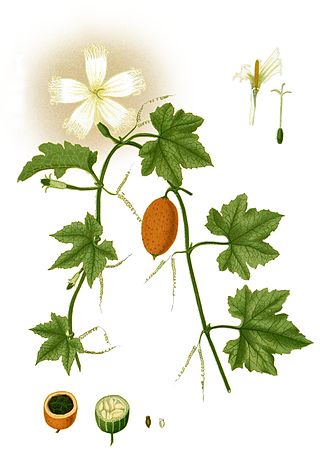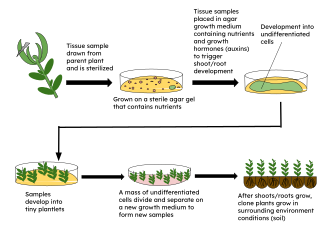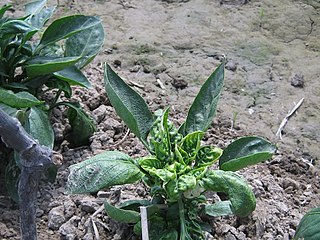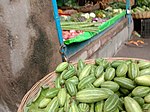
Hydroponics is a type of horticulture and a subset of hydroculture which involves growing plants, usually crops or medicinal plants, without soil, by using water-based mineral nutrient solutions. Terrestrial or aquatic plants may grow with their roots exposed to the nutritious liquid or the roots may be mechanically supported by an inert medium such as perlite, gravel, or other substrates.

Vitamin C is a water-soluble vitamin found in citrus and other fruits and vegetables, also sold as a dietary supplement and as a topical "serum" ingredient to treat melasma and wrinkles on the face. It is used to prevent and treat scurvy. Vitamin C is an essential nutrient involved in the repair of tissue, the formation of collagen, and the enzymatic production of certain neurotransmitters. It is required for the functioning of several enzymes and is important for immune system function. It also functions as an antioxidant. Most animals are able to synthesize their own vitamin C. However, apes and monkeys, most bats, some rodents, and certain other animals must acquire it from dietary sources.

Azadirachta indica, commonly known as margosa, neem, nimtree or Indian lilac, is a tree in the mahogany family Meliaceae. It is one of two species in the genus Azadirachta. It is native to the Indian subcontinent and to parts of Southeast Asia, but is naturalized and grown around the world in tropical and subtropical areas. Its fruits and seeds are the source of neem oil. Nīm (नीम) is a Hindustani noun derived from Sanskrit nimba (निंब).

Lychee is a monotypic taxon and the sole member in the genus Litchi in the soapberry family, Sapindaceae.

The cucumber is a widely-cultivated creeping vine plant in the family Cucurbitaceae that bears cylindrical to spherical fruits, which are used as culinary vegetables. Considered an annual plant, there are three main types of cucumber—slicing, pickling, and seedless—within which several cultivars have been created. The cucumber originates from the Himalayas, China, and Northern Thailand, but now grows on most continents, and many different types of cucumber are grown commercially and traded on the global market. In North America, the term wild cucumber refers to plants in the genera Echinocystis and Marah, though the two are not closely related.

Sprouting is the natural process by which seeds or spores germinate and put out shoots, and already established plants produce new leaves or buds, or other structures experience further growth.

The citron, historically cedrate, is a large fragrant citrus fruit with a thick rind. It is said to resemble a 'huge, rough lemon'. It is one of the original citrus fruits from which all other citrus types developed through natural hybrid speciation or artificial hybridization. Though citron cultivars take on a wide variety of physical forms, they are all closely related genetically. It is used in Asian cuisine, traditional medicines, perfume, and religious rituals and offerings. Hybrids of citrons with other citrus are commercially more prominent, notably lemons and many limes.

Trichosanthes is a genus of tropical and subtropical vines. They belong to the cucumber family (Cucurbitaceae), and are closely related to Gymnopetalum. Hodgsonia, formerly included here, is usually considered a well-distinct genus nowadays.

Micropropagation or tissue culture is the practice of rapidly multiplying plant stock material to produce many progeny plants, using modern plant tissue culture methods.

Arbutus unedo is an evergreen shrub or small tree in the family Ericaceae, native to the Mediterranean Basin and Western Europe. The tree is well known for its fruits, the arbutus berry, which bear some resemblance to the strawberry, hence the common name strawberry tree. However, it is not closely related to true strawberries of the genus Fragaria.

Prunus salicina, commonly called the Japanese plum or Chinese plum, is a small deciduous tree native to China. It is now also grown in fruit orchards in Vietnam, Korea, Japan, Israel, the United States, and Australia.

Citrullus colocynthis, with many common names including Abu Jahl's melon,colocynth, bitter apple, bitter cucumber, egusi, vine of Sodom, or wild gourd, is a desert viny plant native to the Mediterranean Basin and Asia, especially the Region of Palestine, Turkey, and Nubia.

Trichosanthes cucumerina is a tropical or subtropical vine. Its variety T. cucumerina var. anguina raised for its strikingly long fruit. In Asia, it is eaten immature as a vegetable much like the summer squash and in Africa, the reddish pulp of mature snake gourd is used as an economical substitute for tomato. Common names for the cultivated variety include snake gourd, serpent gourd, chichindapadwal and Snake Tomato.

Hippophae rhamnoides, also known as sea-buckthorn, is a species of flowering plant in the family Elaeagnaceae, native to the cold-temperate regions of Europe and Asia. It is a spiny deciduous shrub. The plant is used in the food and cosmetics industries, in traditional medicine, as animal fodder, in horticulture, and for ecological purposes.

Backhousia citriodora is a flowering plant in the family Myrtaceae, genus Backhousia. It is endemic to subtropical rainforests of central and south-eastern Queensland, Australia, with a natural distribution from Mackay to Brisbane.
Bihari cuisine is eaten mainly in the eastern Indian state of Bihar, as well as in the places where people originating from the state of Bihar have settled: Jharkhand, Eastern Uttar Pradesh, Bangladesh, Nepal, Mauritius, South Africa, Fiji, some cities of Pakistan, Guyana, Trinidad and Tobago, Suriname, Jamaica, and the Caribbean. Bihari cuisine includes Angika cuisine, Bhojpuri cuisine, Maithil cuisine and Magahi cuisine.

Cucurbitacins are a class of biochemical compounds that some plants – notably members of the pumpkin and gourd family, Cucurbitaceae – produce and which function as a defense against herbivores. Cucurbitacins and their derivatives have also been found in many other plant families, in some mushrooms and even in some marine mollusks.

Kazi M. Badruddoza was a Bangladeshi agronomist who is credited with using Agricultural Genetics and Plant Pathology to extensively increase agricultural production in Bangladesh thus leading the nation toward self sufficiency in staple cereal crops. He is known as the Father of Modern Agriculture in Bangladesh and the only National Emeritus Scientist of Bangladesh. He was one of the early leaders of the global team of the green revolution for his role in development of high yielding wheat, rice and maize varieties. For his work in Agricultural genetics, Badruddoza was awarded numerous honors, including the Independence Day award, the highest civilian award of Bangladesh. Prior to creation of Bangladesh as an independent state, he was also awarded the Tamgha-e-Imtiaz, a state organized civil award, in former West Pakistan. In addition, he is credited with the genetic engineering for the highly nutritious and large variety of guava, the Kazi Guava. In his honor, the genus of fungus, Kaziboletus. in the family Boletaceae, discovered in Bangladesh, was named after him.

Pepper leaf curl virus(PepLCV) is a DNA virus from the genus Begomovirus and the family Geminiviridae. PepLCV causes severe disease especially in pepper (Capsicum spp.). It can be found in tropical and subtropical regions such as Thailand and India, but has also been detected in countries such as the United States and Nigeria. This virus is transmitted by an insect vector from the family Aleyrodidae and order Hemiptera, the whitefly Bemisia tabaci. The primary host for PepLCV are several Capsicum spp.. PepLCV has been responsible for several epidemics and causes severe economic losses. It is the focus of research trying to understand the genetic basis of resistance. Currently, a source of resistance to the virus has been identified in the Bhut Jolokia pepper.
Plant cryopreservation is a genetic resource conservation strategy that allows plant material, such as seeds, pollen, shoot tips or dormant buds to be stored indefinitely in liquid nitrogen. After thawing, these genetic resources can be regenerated into plants and used on the field. While this cryopreservation conservation strategy can be used on all plants, it is often only used under certain circumstances: 1) crops with recalcitrant seeds e.g. avocado, coconut 2) seedless crops such as cultivated banana and plantains or 3) crops that are clonally propagated such as cassava, sweet potato.
























